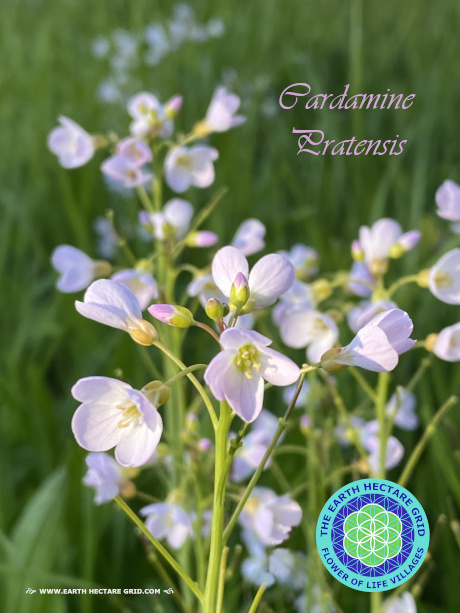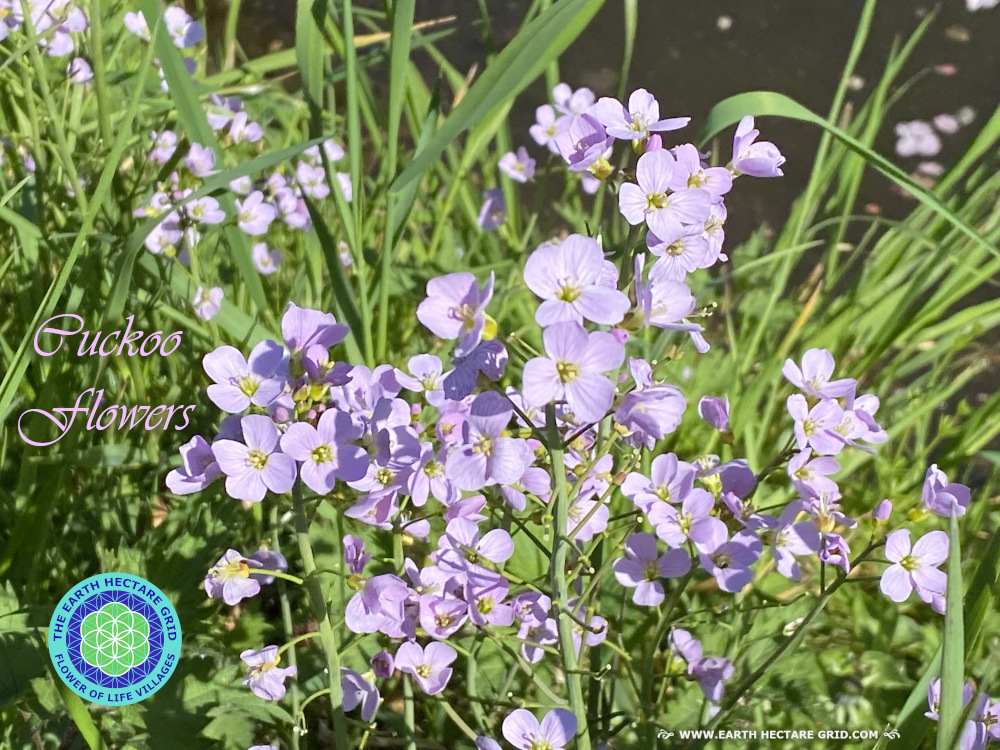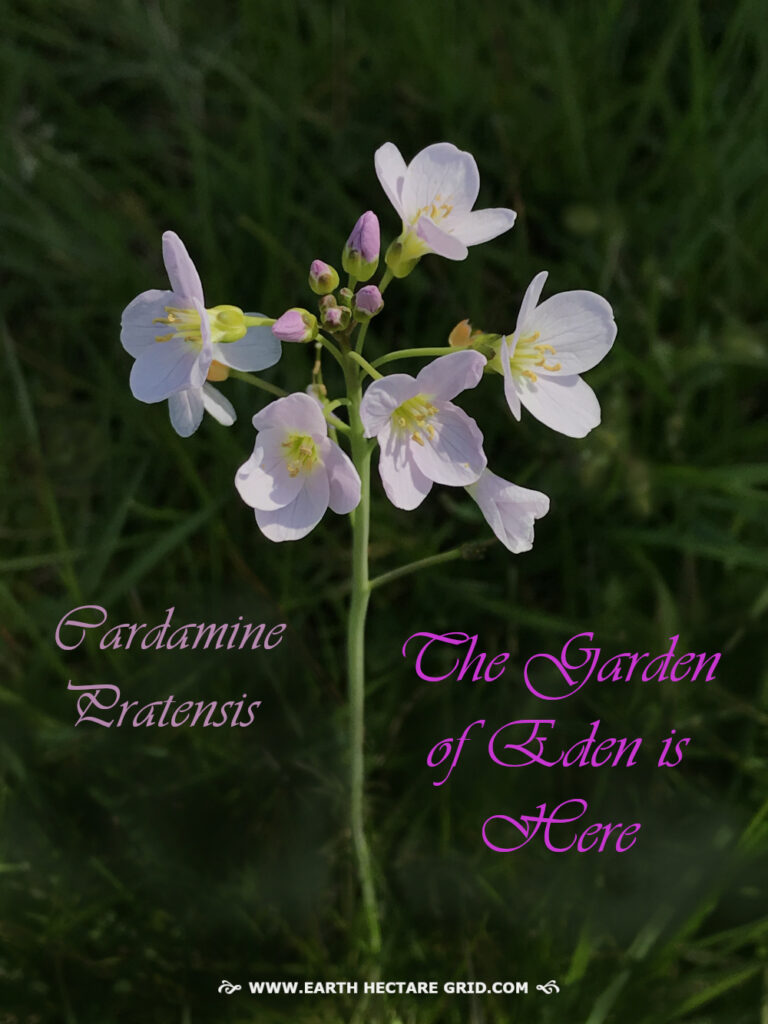THE CUCKOO FLOWER
The cuckoo flower is one of those wild flowers that bloom at a fixed time in spring. That is from the beginning of April to the beginning of June, but it blooms at its best from mid-April to mid-May. So this flower marks the middle of spring.
OTHER FIELD- AND MEADOW FLOWERS
Of course we also see the other field and meadow flowers emerging such as the yellow dandelions (Taraxacum Officinale), the white daisies (Bellis Perennis = beautiful perennial), the yellow buttercups (Ranunculus), the yellow rapeseed (Brassica Napus) the white cow parsley (Anthriscus Sylvestris) and not to forget the blue forget-me-nots (such as Myosotis Sylvatica, which blooms from April to August, and Myosotis Arvensis (field)). Many tree species also bloom at the same time after the fresh foliage has sprouted again. There is already a lot of pollen in the air and spring is really bursting at the seams!
IN FOREST AND BERMES AND ALONG WATER
The cuckoo flower used to color entire meadows lilac. Today, cucko flowers occur in less numbers, but an attentive observer will certainly not overlook them. You can find them in meadows and along the roadsides where they elegantly outrun just above the average height of the grass.
SOFT LILA
They prefer to grow along ditches or at the edges of a pond and in moist woods, both in the sun and partial shade. Their beautiful light soft lilac color and the finely carved four-petal flowers tell you about the wonder of all the budding life and the careful awakening towards summer.

BEGINNING OF SPRING?
Nowadays, spring in the Netherlands starts halfway through winter, because the first week of January we already see snowdrops and daffodils, which are followed in February and March with small spring-flowering bulbs such as crocuses and the blue bells (Hyacinthoides non-scripta), and the white flowering wild garlic (Allium Ursinum).
BEGINNING OF APRIL TO BEGINNING OF JUNE
And then from the beginning of April to the end of May at the beginning of June we see the lilies of the valley (Convallaria Majalis, which grows in forests in shady places and can also be seen in many gardens) and also the cuckoo flower (Cardamine Pratensis), which belongs to the genera Cardamine of the cruciferous family. Cardamine means ‘field cherry’. The word is derived from the Ancient Greek ‘cardaminé’ and the Latin ‘Cardamina’ and the Persian and Indian herb ‘Kardamon’. Pratensis means ‘occurring in the field’). The lily of the valley and the cuckoo flower are the more chic of the entire spring range.
And to finish the list, then the wild summer bloomers start, such as in June the deep red large poppy (Papaver Rhoeas, and Papaver Somniferum) and from June to August the beautiful blue cornflower (Centaura Cyanus), both come in many fields between grain.
NAME ‘PINKSTER’ FLOWER
It is not known why in Duth language the cuckoo flower is named Pinkster bloem. ‘Pinkster’ in Dutch means Pentecost and ‘bloem’ is flower. It is believed that the name refers to the Christian festival of Pentecost (when the Christ-light of the already ascended Christ descended on the apostles). But the cuckoo pinksterbloem usually blooms at its best especially in the period before Pentecost.
THERE WHERE THE PINKS ARE AT
Another possible explanation for the name can be found on the net. During the period when the cuckoo blooms, cows go out to pasture for the first time after a long winter in the stable. One-year-old bulls are also called ‘pink bull’, and a female young bovine a ‘pink heifer’. Pink here doesn’t refer to the colour pink but to the young animals. Thus the ‘pink’ might refer tot the first part of the word Pink-steren.
And there is a Dutch expression: ‘Er als de pinken bij zijn’, which means ‘To be there very quickly’. And these calf bulls and calf heifers go quickly graze all the young fresh tender grass, in which the various field and meadow flowers occur, which are mineral-rich and nutritious for all grazers. And all these flowers bloom around the Pentecost celebration.

The cuckoo flowers here close to a ditch have more of a deeper lilac colour.
It is known that a meadow with wild flowers produces good creamy milk and butter for cattle, and promotes the health of all grazers. These wild flowers and herbs can also have a medicinal effect on livestock. In addition, the mixed flower colors in the meadows are also a feast for the eyes.
FIELD FLOWERS FOR GRAZERS
Please note that cows have four stomacs and thus a much better digestion than for example horses. Some might have a detrimental effect. So do your own research when it comes to growing the below mentioned wild flowers on purpose. Also this list might alter with new insights as we’re in an education permanente…
PROTEÏN RICH
Examples of suitable field and meadow flowers for grazers are: The protein-rich pink-red clovers (Trifolium Pratense), ideal plant fertilizer, also bumblebees and bees visit the bulbous flowers a lot, the plant disappears when artificial fertilizers are used), the yellow rapeseed plants (Brassica Napus), the white chamomile flowers with yellow hearts (Matricaria Chamomilla), the orange Marigold (Calendula Officinalis), flax with blue flowers (Linum Usitatissimum), the seeds of oil flax are linseed, and linen is made from fiber flax).
THEN THERE’S COMFREY
Then there’s comfrey (Symphytum Officinale) with white or pink flowers, and (Symphytum Asperum) with purple flowers, and (Symphytum Tuberosum) with white flowers, these are all deep-rooting plant based fertilizers – if used this way harvest before seed formation- also improves the soil structure, the young plants can be mixed with animal feed.
THEN WE HAVE…
Then we have the orange safflower (Carthamus Tinctorius), its deep taproot can also be used on dry soils and improves the soil structure, thistle-like plant with flowers that change from yellow to orange and red), then cowherb or soapwort (pink flowers (Saponaria Hispanica) or (Vaccaria Hispanica), then we have the orange-flowered nasturtium (Tropaeolum Majus) and the blue cornflower (Centaurea Cyanus).
FOAM HERB
In Dutch and German languages the cuckoo flower’s nickname is ‘foam herb’, this is because of the preference of the ‘foam bug’* for this plant. (*a small insect called Cicada. The eggs are laid in the foam or spit). In Dutch it is then named ‘schuim kruid’ and in German ‘Wiesen-Schaum kraut’.
ORIGIN WORDS ‘PINKSTEREN’ AND ‘PENTECOST’
To come back to the possible reference to Pentecost for the Dutch name of the flower, the word occurs in the thirteenth century already. In a summary of the etymological origin we read the following online: (it’s a bit long, it doesn’t matter if you would want to skip it).
“Mnl. ‘pincst’, Pentecost [1240; Bern.], ‘pincster’, ‘pincxter’, ‘pinxteren in vridages vor pincxteren’ [1282; VMNW], ‘pain star in’ about Pain star [1343-45; MNW]; vnnl. ‘pinckster’, ‘pingstdagh’, ‘pinghsterdagh’, Pentecost, Pentecost Day [1599; Kil.], ‘the three Jaermarckten, sijnde Fair, Fasting and Pinxteren’ [1620; WNT].Borrowed from Late Latin “pentecoste,” Pentecost, which is borrowed from the Greek “pentēkostḕt” (hēmérā) the fiftieth (day), a derivation of “pentḗkonta,” fifty: the feast day falls on the fiftieth day after Easter. The Greek word is formed from “pénte,” five, cognate with five, and the suffix “konta,” tig, cognate with ten.
The original Middle Dutch form was ‘pincsten’; the forms ‘pincster’, ‘pincsteren’ originated in fixed compounds and compounds such as ‘die pincsterdaghe’, the days of Pentecost [1290; VMNW], ‘Whitsunday’, the evening or day before Pentecost [1453-97; WNT], also e.g. Old Frisian ‘anda there pinxtera wika’: in the week of Pentecost, and especially ’to pinxteren’, at Pentecost [1421; MNW kersmisse], in which an inflected form occurs on -er(s) of pincsten, which has finally supplanted the non-inflected form.
The fiftieth day (or seven weeks) after Passover is the Jewish holiday of Shavuot, the Feast of Weeks, originally a harvest festival, later a festival to celebrate that God would have given Moses the Ten Commandments on Mount Sinai. According to Christian belief, on this feast day, fifty days after Easter, the resurrection of Jesus, and ten days after his ascension into heaven, the Holy Spirit would have been poured out on his disciples in Jerusalem and the first Christian community was born. For this feast, in addition to Pentecost, the BN still has the name ‘Sinksen’, especially. sinxene with various spelling variants, as in ‘within the eight days uan pasghen. end uan chincsen. ende uan middewintere’, ‘within the octave of Easter, Pentecost and Christmas’ [1236; VMNW]. Sinksen is borrowed from Old French ‘cinquiesme’, a borrowing from medieval Latin ‘cinquagesima’, fiftieth day after Easter, Latin ‘quīnquāgēsima’, fiftieth.”
RHYTHMS IN NATURE
Apparently many religious holidays are linked to recognizable rhythms in nature, for example the solstice in winter is related to the birth of Christ, as a symbol of the return of light, and then with the budding of spring, when the birds lay eggs, symbolised with Easter eggs, the chicks and Easter bunnies, the green young fresh foliage that comes back to the trees, refers again to the return of light or the renewal of life through the Pentecost celebration.Obviously this has been set either symbolically or according to calendar data linked to events that happend more than 2000 years ago.
PENTECOST FLOWER FIGURATIVELY
And so we can go on and on. There also appears to be another meaning of the words ‘pentecostal flower’, something that I’ve never heard of myself. But I think this indeed existed. We’ve got to remind ourselves in these days were no televisons nor radios thus the folkore festivals were the public celebrations, meeting points and information gatherings.
One of those old Dutch folklore festivals was on Pentecost day, when a boy or girl were beautifully dressed and guided through the village. He or she was then called ‘Pinksterblom’. The second phrase of this word ‘blom’ is short voor bloem = flower. Sometimes children were also pinksterblom. During the guided tour of the chosen children or young lady or gentleman, songs were sung and donations were collected from the citizenry.
PENTECOST BRIDE
If the Pentecostal ‘blom’ was a (marriageable) girl, she was also called ‘Pentecost bride’. In Germany, the phenomenon is also known as ‘pfingstbraut’, but with a slightly different interpretation (in relation to the may celebration and the ‘maimann’).
The Pentecostal bride could be the prettiest girl in the village, but she could also be of a wealthy background, or chosen for other reasons. According to the internet, because the youth were in public during this festivity, they were able to get to know each other and the single young men made their appearance at the end of the celebration.
FAR BEFORE THE MIDDLE AGES
The folklore festivity probably dates back to long before the Middle Ages. The procession of the boys and girls with the Pentecostal bride (or groom?) in their midst led through the village, and it may have been several villages since there were also many small hamlets in all areas in earlier times.
According to the internet, this celebration is still being continued as a children’s party in the east and south of the Netherlands and on the Wadden Islands. An illustration from that time can also be seen online of children dressed up as a shepherd couple, with a garland of flowers on both heads. Perhaps they were already married off to each other, or they symbolized spring time, or they represented the village or town where they were from, or there was a reference to the Christian tradition of Pentecost.
THE PENTECOST CROWN
The Pentecostal crown was a garland of greenery and flowers that was hung at Pentecost, or worn as a headdress by boys and girls during the spring festival.
MORE ‘PENTECOSTAL’ FLOWERS
However, at that time several wild flowers were referred to as ‘Pentecostal flowers’. These were apparently all field and meadow flowers that causes a furore in mid-spring, and which were incorporated into the bridal or spring decorations of the candidates. For example, the cow parsley was also referred to as Pentecostal flower in the provinces Groningen and Friesland. The yellow iris was also referred to as such. Daisies have traditionally been strung into necklaces. And the peony is also known as ‘Pentecostal rose’.

THE PINXTERBLOM
When a girl from the village was crowned as a Pentecostal bride, she was also called ‘Pinxter blom’ (different old Dutch spelling) or ‘Rosa’ and, together with other girls and boys, went door-to-door singing and dancing. (This is also somewhat reminiscent of the earlier carnival floats, or flower parades with villagers also adorned with flowers). For example, the spring flowers refer to fertility and the vigor of spring with the new budding life and with it the budding love that also relates to us humans.
ON THE CARRIER
Below is an anecdote recorded in manuscripts by Andries Schoemaker (1660-1735). This Amsterdam textile merchant has recorded a lot of historical information about the cities and villages. With this he gives some insight into the old usage. About his visit to Schermerhorn around Pentecost (in 1718) he describes the image of four girls carrying a stretcher.
The carrying frame or stretcher was a wooden platform or slab that rested with beams on the shoulders of the four young women, which they held above their shoulders with their hands. A fifth girl stood on the platform, towering high above the heads of the porters. Andries described her as ‘a nice and for us unusual Pinxterblom who was very nicely decorated’:
“Did we see from afar a pretty and for us unusual pinxterblom approaching us (…) Four fluxse young shun, reasonably well dressed. Each with a garland of flowers about the head. These four carried a burrie (a carrying frame or wooden platform). On which burrie stood a fifth young maiden, who was very nicely decorated. The standing daughter was hung with twenty silver harnesses, ten silver bells, three shackles, and twenty-five chains as amber as red coral. I counted about her body 23 silver twigs. She held in one hand a small silver bowl. In which it is believed that one made friends with this pinxterblom.”
The ‘Pinxterblom’ was therefore carried through the village and sang songs (“Her gesange were shod after the peasant last”), which was rewarded with money. Apparently it was a jolly affair, with the girls having to endure some verbal abuse, but these were up to it:
“What surprised me the most was that the dearn that depicted the pinxterblom -according my thoughts she must be about 14 to 16 years-, managed to keep herself so unusually stately, although they talked to her in a slightly uncivil manner, that she didn’t put her mouth in the least bit of laughter, but heard it all stately.”

The Yellow Lis (in Dutch language), Iris Pseudacorus. This is a perfect flower for around the pond on your homestead. It is also often seen near ditches and other waterbodies. Collect the seeds at the end of may and first two weeks of june.
COLD SPRING
Now that the blooming time of the cuckoo flower is coming to an end, we can look back on this spring of 2023, which was rather cool in the Netherlands, and also other parts of the northern hemisphere. There were days with sun, but the wind often brought a light freezing cold, coming from the north. And even though that sun occasionally shone exuberantly, and this month of May all the trees were covered again with beautiful green leaves, there was an icy chilly undertone of the wind, and it just wouldn’t go away.
FORERUNNER
However, that will also change. Because as the previous pattern of recent springs has shown us, the drought suddenly returns after a very wet winter and spring, which was the same for the cool spring of two years ago. How is it possible that we have to water all our trees and shrubs, plants and crops in the middle of spring? It’s strange. Perhaps it is a harbinger of another prolonged drought? Then we must be vigilant for nature and put the water management in order. So that all crops will thrive and the summer wild flowers may also flourish. There is always room for a beautiful field bouquet!
Spring Greetings,
Margreet Wilschut

Terug naar het MENU

